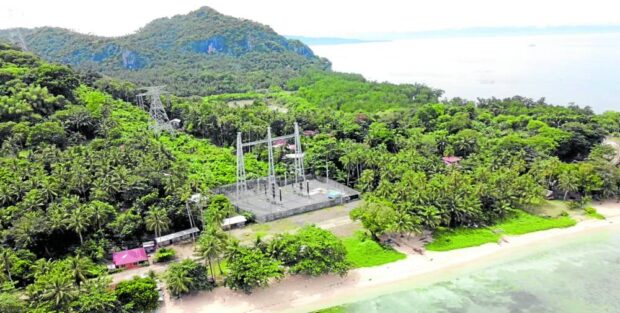PH power grid ‘highway’ online for stable supply

VIS-MIN LINKUP | The Dapitan Cable Terminal Station of the Mindanao-Visayas Interconnection Project in Zamboanga del Norte houses the endpoint of the submarine cable going to Santander, Cebu, bringing power from Mindanao to Visayas and back. (Photo courtesy of the National Grid Corporation of the Philippines)
MANILA, Philippines — The country now has a unified power highway with the activation of the P52-billion Mindanao-Visayas Interconnection Project (MVIP), finally enabling electricity supply from generation plants anywhere in the country to be distributed across the archipelago’s three main island groups.
The National Grid Corp. of the Philippines (NGCP), the private firm operating and developing the government’s power grid—the interconnected network of distribution and transmission lines that deliver electricity from producers to consumers—on Wednesday confirmed it had switched on the MVIP, which is expected to improve power stability and reliability nationwide.
According to NGCP, an initial load of 22.5 megawatts was carried by a high-voltage submarine cable, which transmits power underwater, and overhead lines from Mindanao to Visayas on April 30.
“We expect to gradually increase the MVIP’s transfer capacity to 50 MW by mid-May, and 112 MW by the end of the month, before energizing to its full transfer capacity of 450 MW by the third quarter of this year,” NGCP said in a statement.
At such a maximum load, it is estimated to provide electricity to as many as 450,000 households.
Article continues after this advertisementPrior to the MVIP opening, Mindanao had a separate power grid, which meant it sourced its needs locally, incapable of transmitting electricity to or getting additional supply from Luzon and the Visayas.
Article continues after this advertisementThe MVIP connects the Mindanao grid to the Visayas transmission network, which has been connected to the Luzon grid since 1998 through a transmission line and submarine cable between Naga in the Bicol region and Ormoc in Leyte.
The Department of Energy (DOE) said the project, which began construction in 2018 and started testing the power lines last March, would help ensure adequate electricity by boosting supply anywhere in the country.
Luzon, the biggest island group, historically has the highest electricity demand and is therefore more prone to yellow alerts, or thinning power reserves, especially during the summer months. Last year, NGCP declared at least four yellow alerts in Luzon in the month of December alone.
Mindanao, the southernmost island group that often had sufficient electricity supply, relies on hydroelectric and coal-fed power plants as well as barges, or floating power facilities that are easy to deploy during emergencies, to energize homes for the longest time.
It particularly sources power from Lake Lanao in Marawi City and Pulangi River in Bukidnon.
The Visayas islands, on the other hand, depend largely on solar power plants to meet its growing electricity demand, specifically in the populous Cebu province.
DOE Undersecretary Rowena Guevara earlier said that the MVIP could help augment supply in the Visayas—especially at night—by getting more supply from Mindanao.
Connecting all three islands through one national grid would therefore help solve power supply deficiencies by sharing electricity output and any excess supply from MVIP would be transmitted to power-hungry Luzon.
“The completion of the [MVIP] is a significant achievement for us and for the Philippines as a whole. This will not only improve the reliability of our transmission services but will lead to efficient energy utilization as one Philippine grid,” NGCP said.
No rate impact
MVIP is composed of a 184-circuit-kilometer high-voltage direct current submarine transmission line.
Once fully operational, its transfer capacity, or the maximum amount of electricity it can deliver, will be 450 MW, although this could be doubled to 900 MW, according to NGCP.
In January, the Independent Electricity Market Operator of the Philippines formally launched the Wholesale Electricity Spot Market (WESM) in Mindanao.
The opening of MVIP integrates WESM Mindanao into the national power market, allowing it to trade electricity with Luzon and Visayas.
Distributors such as Manila Electric Co. (Meralco) buy electricity from suppliers who trade in the spot market to meet any shortfall from its contracted suppliers.
WESM costs typically influence a Meralco customer’s electricity bill through the generation charge, or the cost of purchased power that accounts for 55 percent of the monthly bill.
Asked if connecting the Mindanao grid to the national grid through MVIP would result in higher cost of electricity, DOE’s Guevara said: “Not really.”
“We monitor the market every day and there are times when it (electricity price) really goes down. You have to look at the day-to-day [market movement]. I imagine that since we have been campaigning demand-side management, we expect that it would not be that bad,” she told reporters in an earlier interview.
Parts of the MVIP were completed in 2022 and NGCP said it “expects to complete the remaining components of the project and ramp up the transfer capacity of the facility in the coming months.”
MVIP was originally scheduled for completion in December 2020, but restrictions triggered by the pandemic forced NGCP to push back the start of its operations to this year.